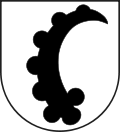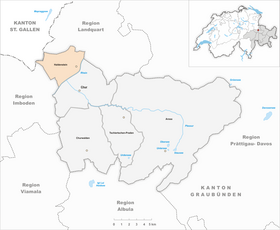Haldenstein
| Haldenstein | |
|---|---|
| State : |
|
| Canton : |
|
| Region : | Plessure |
| BFS no. : | 3941 |
| Postal code : | 7023 |
| Coordinates : | 759 170 / 194 092 |
| Height : | 566 m above sea level M. |
| Height range : | 537–2753 m above sea level M. |
| Area : | 18.56 km² |
| Residents: | 1033 (December 31, 2018) |
| Population density : | 56 inhabitants per km² |
| Website: | www.haldenstein.ch |
|
Haldenstein |
|
| Location of the municipality | |
Haldenstein (in local dialect [ ˈhaːldəˌʃtɑj ], Rhaeto-Romanic ) is a village north of Chur , on the left bank of the Rhine . The rule , attested since 960, has formed a political municipality in the Plessur region in the Swiss canton of Graubünden since 2016 . In 2019 and 2020, the citizens of Haldenstein and Chur voted on a merger of the two political communities.
geography
Haldenstein is 3 km north of Chur on the left bank of the Rhine . The municipal ban extends from the river, which forms the south-eastern border for around 6 km and which is 540 m above sea level. M. lowest point marked, up to the ridge of the Calanda massif , where the Haldensteiner Calanda with 2804 m above sea level. M. the greatest height is reached. Neither the tip of the Haldensteiner nor the Felsberger Calanda belong to the territory. In addition to the clustered village Haldenstein, the community includes a number of Maiensässen on the Calandahang, including the hamlet Batänja (1400 m), which was inhabited all year round until 1868 .
18% of the municipality is unproductive, 54% is forested and 26% is used for agriculture, with only 5% being meadow and arable land in the valley floor, the rest being alpine pastures.
Neighboring communities are the city of Chur, Felsberg , Untervaz , Trimmis and Pfäfers in the canton of St. Gallen .
geology
The Calanda is built up to a large extent from limestone , which is assigned to the Helvetic deposit area. There are several rock scales lying on top of each other. Malm limestone form the rock slabs west of Haldenstein. Chalk limestone forms, among other things, the striking rock rib that runs from the climbing garden over the Lichtenstein ruins to the Grottenstein ruins. In addition, marl layers also occur in the chalk shed towards the Calanda . The Calanda is thinly covered by moraine deposits . In the northern part of Haldenstein the subsoil is built up by rock fall blocks.
coat of arms
Blazon : In silver a black ibex horn on stakes with a horn root , coat of arms of the Lords of Haldenstein.
history
The earliest archaeological finds in Haldenstein date from the Neolithic Age and were made near the Lichtenstein ruins. A late Bronze Age settlement could be proven in the village area (around 800 BC). Roman settlement remains were found in Haldenstein Castle. The village was probably first mentioned in a document in 1149 as a designation of origin for the personal name Iohannes de Lanze . In 1375 the place name appears as Lentz inferior («Unterlenz»); the equivalent of the addition used to distinguish Oberlentz lives on in today's Romance name Lantsch sut . With the transition to the German language, the name of the Haldenstein Castle above the village replaced the older settlement name, the origin of which is not clear , from the 14th century .
In the 13th and 14th centuries, the Knights of Haldenstein owned the castle and village as a fief of the Diocese of Chur . In 1424 Peter von Grifensee acquired all sovereign rights, so that Haldenstein from now on (until 1803) was an autonomous baron , independent of the Three Leagues . After several changes of ownership, in 1542 the French ambassador Jean Jacques de Castion came into the possession of the dwarf state through marriage. The new castle was built in 1544–1548, which gradually replaced the castle as the center of power. In 1558 the federal towns decided that the patronage of Haldenstein would go to the Three Leagues, but this was not recognized until 1568 by Gregor Carl von Hohenbalken as Lord von Haldenstein.
In the centuries that followed, the Haldensteiners had to come to terms with frequently changing masters. Thomas von Schauenstein received the right to mint from the emperor in 1612, which was used to mint gold and silver coins. He introduced the Reformation from 1613 to 1616 , in which he received church support from the Protestant pastors Georg Saluz and Johann Pontisella from Chur .
In 1701 the rule went to the Lords of Salis . Johann Luzius von Salis lifted serfdom in the same year . The rule was still not part of the Three Leagues.
In 1803 Haldenstein came to Graubünden. In 1825 a large part of the village burned down. In 1943, a forest fire from the target area of the Chur shooting range hit the entire Calanda slope, but spared the village.
Merger with Chur: In November 2019, the citizens voted on a merger with the city of Chur. The result was extremely close. 253 voted yes, 251 voted no. In February 2020, the citizens of Chur voted on the merger. As expected, 80% voted for a merger with Haldenstein.
population
The population of Haldenstein increased significantly in the last 200 years as a whole and in the last third of the 20th century after an intermittent slump.
| Population development | ||||||||||
|---|---|---|---|---|---|---|---|---|---|---|
| year | 1803 | 1850 | 1900 | 1950 | 1970 | 1980 | 1990 | 2000 | 2002 | 2005 |
| population | 349 | 492 | 464 | 521 | 478 | 671 | 677 | 808 | 855 | 894 |
economy
In Haldenstein, 274 people find employment, 13% of whom work in the primary sector (agriculture), 44% in the secondary (industry / trade) and 43% in the service sector (as of 2002). Around two thirds of the residents of Haldenstein find work outside the community, for example in Chur. In addition to agricultural operations, there are commercial and industrial operations in Haldenstein - bakery, carpentry, metal construction, packaging machine construction, gravel works. Since spring 2013, the Calandawind wind turbine in Haldenstein has been the first large wind turbine in the Canton of Graubünden. This should produce as much electricity as is used in Haldenstein.
traffic
The community is located near the Chur-Nord motorway junction on the A13 . It is connected to the public transport network with the Haldenstein station of the Rhaetian Railway (located across the Rhine in Chur) and the Chur city bus line 3.
Culture and sights
- Reformed Church from 1732.
- Haldenstein Castle . The ancestral castle of the Knights of Haldenstein, built in the 12th century, was inhabited at least until 1695. In the 18th century it fell into disrepair, to which an earthquake in 1787 contributed significantly. In addition to the triangular keep with five storeys, the remains of the wall of the residential wing have been preserved.
- Lichtenstein Castle , popularly called Katzenburg . The festivals of the lords of Lichtenstein mentioned in 1180, who are probably related to the Knights of Haldenstein, date from the same era. It was already referred to as a ruin in the 16th century.
- Grottenstein Castle . There is no documentary evidence of the cave castle located under a rocky promontory . A 20 m long section of the front wall still exists.
- Haldenstein Castle . The castle, built in the Renaissance style on the edge of the village in the 16th century, was renovated in 1732 after a fire. In the possession of Salis-Maienfeld since 1701 , it housed an educational institution for philanthropism from 1763–1771 . Today the building, which has belonged to a foundation since 1966 and was restored from 1986 to 2005, is used by the municipal administration and the canton's archaeological service. Since 2001, an open-air opera has been performed in the castle every two years by the Kammerphilharmonie Graubünden under the direction of Marcus R. Bosch .
- Ensemble Zumthor: Atelier Zumthor, 1986 and residential and studio building Zumthor, 2004, architect: Peter Zumthor
- Clavuot-Merz House, 2002, architect: Conradin Clavuot
Personalities
- Peter Zumthor (* 1943), architect, lives and works in Haldenstein
- Peter Conradin Zumthor (* 1979), musician (drums and others), born and raised in Haldenstein
- Gimma (* 1980), rapper, lives in Haldenstein
literature
- Erwin Poeschel : The Art Monuments of the Canton of Graubünden, Volume VII: The City of Chur and the Circle of Five Villages. (= Art Monuments of Switzerland. Volume 20). Edited by the Society for Swiss Art History GSK. Bern 1948, DNB 760079668 .
- Georg Lütscher: History of the Freiherrschaft and municipality Haldenstein. Revised and supplemented by Silvio Margadant. Haldenstein 1995, ISBN 3-905241-51-X .
- Otto P. Clavadetscher, Werner Meyer : The castle book of Graubünden. Zurich 1984, pp. 297-302, ISBN 3-280-01319-4 .
- Mathis Berger: The state position of the Haldenstain rule in history. Bündnermonthsblatt , 1956, No. ¾ p. 61ff.
Web links
- Silvio Margadant: Haldenstein. In: Historical Lexicon of Switzerland .
- Official website of the Haldenstein community
Individual evidence
- ↑ Permanent and non-permanent resident population by year, canton, district, municipality, population type and gender (permanent resident population). In: bfs. admin.ch . Federal Statistical Office (FSO), August 31, 2019, accessed on December 22, 2019 .
- ^ A b Andres Kristol: Haldenstein GR (Landquart). In: Dictionnaire toponymique des communes suisses - Lexicon of Swiss municipality names - Dizionario toponomastico dei comuni svizzeri (DTS | LSG). Center de dialectologie, Université de Neuchâtel, Verlag Huber, Frauenfeld / Stuttgart / Vienna 2005, ISBN 3-7193-1308-5 and Éditions Payot, Lausanne 2005, ISBN 2-601-03336-3 , p. 427
- ^ Rudolf Jenny (ed.): Document collections in the Graubünden State Archives. Part 2. Regesten in chronological order 9th century – 1877 for the increase in documents from 1967–1970 and inventory of the document collections. (Sources on the cultural and regional history of Graubünden, Vol. IV). Chur 1977, p. 115f., 117
- ^ Website of the Evangelical Reformed Church Haldenstein
- ↑ Silvio Margadant: Historical Dictionary of Switzerland, Haldenstein
- ↑ Daniel Steffen: Flight through hell In: Neue Zürcher Zeitung of August 18, 2018
- ↑ 70 years ago a devastating great fire raged on the Calanda
- ^ The forest fire at Felsberger Calanda
- ↑ Southeast Switzerland November 22, 2019 Tight decision: Two voices make the difference in Haldenstein
- ↑ southeast Switzerland, February 9th, 2020 The Chur electorate said “Yes” to Haldenstein's wedding. With almost 80 percent, Chur has given a clear signal.
- ↑ data
- ↑ Calandawind.ch
- ^ Ensemble Zumthor: Atelier Zumthor
- ^ Ensemble Zumthor: Zumthor residential and studio house
- ^ House Clavuot-Merz












